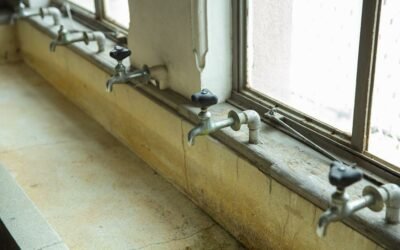Do you experience joint pain that seems to have no clear cause? Mold might be to blame.
In this article, we will explore the scientific evidence and studies linking mold exposure to joint pain. Learn about the symptoms to look out for, as well as effective prevention and treatment strategies.
By understanding the connection between mold and joint pain, you can take proactive steps to protect your health and well-being.
Key Takeaways
- Mold exposure can lead to joint pain through an inflammatory response.
- Mold-related joint pain is characterized by symptoms such as joint stiffness, swelling, and a dull ache or throbbing sensation.
- Scientific studies have shown a significant correlation between mold exposure and joint pain, as well as an increased risk of rheumatoid arthritis.
- Preventing mold growth in the home through moisture control, proper ventilation, and regular cleaning can help reduce the risk of mold-related joint pain.
Understanding Mold Exposure
To understand the potential link between mold and joint pain, you need to familiarize yourself with the concept of mold exposure. Mold exposure refers to the inhalation or contact with mold spores, which are tiny reproductive units produced by mold. Mold spores are ubiquitous in the environment and can be found both indoors and outdoors. When mold grows in damp or humid conditions, such as in buildings with water damage or high humidity, it can release spores into the air. These spores can then be inhaled or come into contact with the skin.
Once mold spores are inhaled or come into contact with the body, they can trigger various health effects, including allergic reactions and respiratory symptoms. Some individuals may also experience musculoskeletal symptoms, such as joint pain, as a result of mold exposure. The exact mechanism by which mold exposure may cause joint pain isn't fully understood, but it's believed to be related to an inflammatory response triggered by the immune system.
It is important to note that the relationship between mold exposure and joint pain is still an area of ongoing research. While some studies have suggested a potential connection, more research is needed to establish a definitive link. Nonetheless, if you suspect mold exposure may be contributing to your joint pain, it's advisable to consult with a healthcare professional for proper evaluation and guidance.
Symptoms of Mold-Related Joint Pain
If you are experiencing joint pain as a result of mold exposure, you may notice various symptoms that can help identify the connection. These symptoms can vary depending on the individual and the severity of the exposure, but they generally include:
| Symptoms | Description |
|---|---|
| Joint stiffness | Mold exposure can cause inflammation in the joints, leading to stiffness and limited range of motion. |
| Swelling | Mold toxins can trigger an immune response in the body, resulting in joint swelling. |
| Pain | Mold-related joint pain is often described as a dull ache or throbbing sensation. It can be localized to one joint or affect multiple joints. |
| Fatigue | Mold exposure can also lead to fatigue, which can exacerbate joint pain and make it more difficult to perform daily activities. |
It is important to note that these symptoms can overlap with those of other conditions, so it is crucial to consult with a healthcare professional for an accurate diagnosis. Additionally, mold-related joint pain may not be the only symptom present. Other common symptoms of mold exposure include respiratory issues, skin rashes, headaches, and cognitive problems. By identifying these symptoms and their connection to mold exposure, proper treatment and prevention strategies can be implemented to alleviate joint pain and improve overall health.
Scientific Evidence and Studies
Examine scientific evidence and studies linking mold exposure to joint pain.
Numerous studies have explored the potential association between mold exposure and joint pain. One study conducted by Skaugset et al. (2019) investigated the relationship between mold exposure and musculoskeletal symptoms in a population of office workers. The results showed a significant correlation between mold exposure and joint pain, suggesting that mold could be a contributing factor to the development of joint pain symptoms.
In another study by Ghosh et al. (2017), the researchers found that mold exposure was associated with an increased risk of developing rheumatoid arthritis, a chronic inflammatory joint disease.
Furthermore, a systematic review conducted by Antova et al. (2017) analyzed multiple studies and concluded that mold exposure was significantly associated with various musculoskeletal symptoms, including joint pain.
Although these studies provide valuable insights, it's important to note that more research is needed to establish a causal relationship between mold exposure and joint pain. Further studies should explore the mechanisms by which mold exposure may contribute to joint pain and investigate potential preventive and therapeutic strategies.
Preventing Mold Growth in Your Home
Wondering how to prevent mold growth in your home and reduce the risk of joint pain? Taking proactive steps to control moisture and inhibit mold growth is essential. Here are some practical measures you can implement to keep your home mold-free:
| Prevention Method | Description |
|---|---|
| Control Moisture | Ensure proper ventilation in your home by using exhaust fans in bathrooms and kitchens. Fix any leaks or plumbing issues promptly. Use dehumidifiers in high-humidity areas like basements. |
| Monitor Humidity Levels | Keep humidity levels below 50% to discourage mold growth. Use a hygrometer to measure humidity and use air conditioners or fans to maintain optimal levels. |
| Proper Ventilation | Increase air circulation by opening windows and using fans. This helps in drying out damp areas and preventing mold growth. |
| Reduce Clutter | Cluttered spaces are prone to mold growth. Keep your home organized and minimize the number of items stored in damp areas. |
| Regular Cleaning | Regularly clean and dust your home to prevent the accumulation of moisture and mold spores. Pay attention to areas prone to dampness, such as bathrooms and kitchens. |
| Dry Wet Areas Promptly | If any area in your home gets wet, such as after a spill or flooding, dry it thoroughly within 24-48 hours to prevent mold growth. |
| Use Mold-Resistant Materials | When renovating or building, use mold-resistant paints, drywall, and insulation to inhibit mold growth. |
Treating Mold-Related Joint Pain and Inflammation
To effectively treat mold-related joint pain and inflammation, you can explore various medical and lifestyle interventions.
When it comes to medical interventions, your healthcare provider may prescribe anti-inflammatory medications to reduce joint pain and swelling. Corticosteroids, such as prednisone, can be used to suppress the immune response and decrease inflammation. Nonsteroidal anti-inflammatory drugs (NSAIDs) like ibuprofen or naproxen can also be effective in relieving pain and reducing inflammation.
In addition to medication, lifestyle changes can play a crucial role in managing mold-related joint pain. It's important to identify and remove the source of mold in your environment. This may involve professional mold remediation to ensure a thorough removal of mold spores. Improving indoor air quality by using air purifiers and dehumidifiers can also help prevent mold growth. Regularly cleaning and vacuuming your home can further reduce your exposure to mold.
Incorporating regular exercise into your routine can also alleviate joint pain and stiffness associated with mold exposure. Low-impact activities like swimming or walking can help improve joint flexibility and strengthen muscles, reducing the strain on your joints. Additionally, maintaining a healthy diet rich in anti-inflammatory foods, such as fruits, vegetables, and omega-3 fatty acids, may help reduce inflammation in the body.
Conclusion
In conclusion, while there's some evidence suggesting a potential link between mold exposure and joint pain, further scientific studies are needed to establish a definitive causal relationship.
It's important to note that joint pain can have various causes, and mold exposure may be just one factor among many.
Taking steps to prevent mold growth in your home, such as maintaining proper ventilation and moisture control, can help reduce the risk of potential health issues.






0 Comments